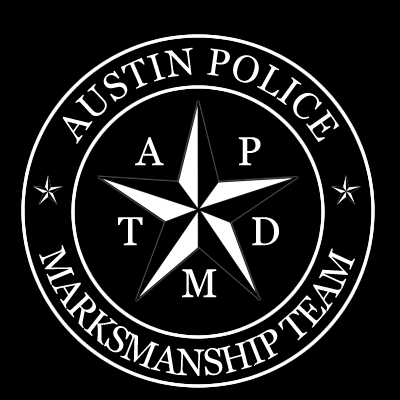The pistol comes in a cordura carrying case. It has a large pocket in the middle for the pistol. On the outside are two zipper pockets, on the other side are 7 individual pockets for magazines secured by a Velcro flap. The pistol ships with two Wilson 8 round ETM magazines. Mine accidentally came with one .45 mag and one 9mm mag. I think they are telling me to buy another pistol. Instead of maxing out my credit card I called Wilson and a .45 mag is on the way.
This pistol is the Wilson CQB elite. The CQB could be considered a base 5’’ model. The elite adds a magwell, slide top serrations, and rear of slide serrations. The wait time for this pistol is currently somewhere around 6 months to over a year. I didn’t want to wait that long and I found one that had almost all the features I wanted at a distributor. The options on this pistol are a single side safety, flush cut barrel, no front cocking serrations, and flush cut slide stop. None of these options change the functionality of the pistol and are just things I prefer for aesthetics.
The pistol has an exceptionally solid feel in the hand. When I shake it side to side there is no movement or rattle, it is just solid. The pistol came in Wilson’s armor tuff black finish. I believe Wilson does something proprietary with the finish but it is similar to cerakote. The finish is smooth and even. The only test will be to see how it wears over time.
I plan to use the pistol in competition so I wanted a magwell. Since 1911s use a single stack mag as opposed to a double stack there is no taper at the top of the mag. This makes fast reloads much more difficult if there is no magwell. The magwell only adds about a ¼ inch to the length of the grip and most 8 round magazines stick out this far anyway. Wilson uses all of their own parts. On this pistol they are all Wilson’s bulletproof barstock parts. The magwell is a one piece part. The magwell is blended superbly with the frame. There is a seam visible but it can barely be felt. Nothing that is going to catch a mag. The front of the magwell has a slight bevel to remove any sharp corners. The rear of the magwell has a bevel. Wilson also has a round butt style which provides much more rounding at the back of the magwell and into the mainspring housing. I like the extra support the non round butt style provides. It blends nicely and I have plenty of support from the frame and magwell on my hand. The advantage of the round but style is that if you carry it there is less pistol sticking out. The butt of the pistol is the highest point on the pistol if you carry it in waist band.


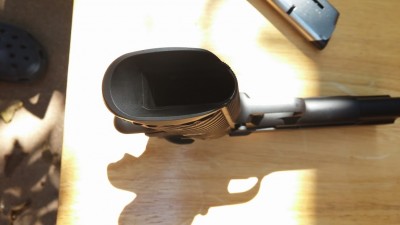
The front strap and backstrap are finished with 30 lpi checkering. I know that 1911 aficionados will have a preference for either hand checkering or machine checkering. I don’t know enough to tell the difference. The checkering is even, straight, and terminates perfectly. On the backstrap I cant tell that there is a seam between main spring housing and the frame. The main spring housing slides out of the bottom of the frame during a full disassembly.
The grips are Wilson’s g10 sunburst pattern. They have a brass colored inlay with Wilson’s logo on them . The wings on the eagle are aligned so they are parallel with the eagle on the slide, a nice touch. I prefer grips with a cutout to access the main spring housing. With a magwell this cutout kind of ruins the aesthetics at the bottom of the grip, so it is more common to use on grips with no magwell. With the cutout you can strip the frame without removing the grips. The top of the grips appear to contact the plunger tube. Plunger tubes can come loose if they are not installed correctly and having the grips contacting the plunger tube adds more support.

The grip safety has a nice feel when engaging and disengaging. There is no play in the travel and it is firm but still easy to disengage. When engaged the contour of the grip safety perfectly matches the frame. There is a very small amount of side to side movement in the grip safety. For this part to move freely there has to be some play. It is less than any other 1911 I have used. At the top of the grip safety the width matches the frame, no overhang on either side. At the top of the grip safety is cutout where the hammer rests when cocked. This recess is smooth and no machining is visible inside.
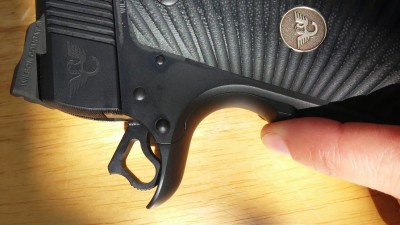


The thumb safety snaps on and off smartly with no extra travel on either end. The thumb safety on this pistol is smaller but still big enough to find naturally and hold my thumb while firing the pistol. The thumb safety is rounded and does not have any sharp points to irritate a thumb. The rear of the thumb safety is contoured and matches the frame. It is also beveled so that it is not sharp against the thumb.

The rear of the slide and frame are phenomenal. For those not familiar there are several parts back here that have to be fitted if they are going to be flush. There is the extractor, ejector, frame, and slide. On the Wilson everything is flush. The bottom of the ejector is perfectly square with the frame. On the horizontal fit of the slide to frame there is no gap visible. There is a slight gap visible between the vertical fit of the frame and slide. When I hold the frame and push the slide left and right and up and down there is no perceptible movement. The extractor is nearly invisible. It is flush and there is no visible difference between the serrations as they move from the slide over the extractor. One of the features of the elite model is that it includes rear of slide serrations. I was indifferent about them but now that I have the pistol I like them. They can reduce glare but I have never had a problem with the rear of a slide blinding me in the past.

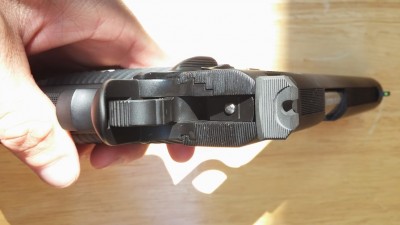
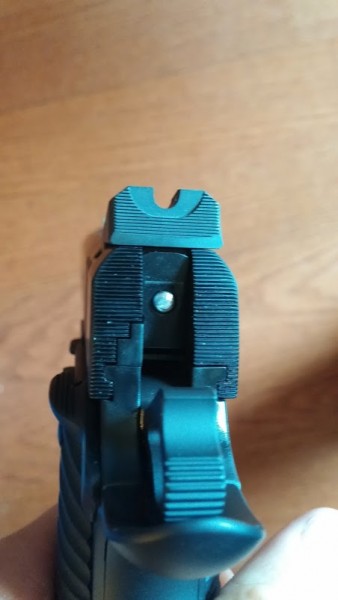
The hammer is a skeletonized design. It is square in the frame and impacts the firing pin stop squarely. There is no side to side movement in the hammer when cocked or forward. The inside skeletonized part of the hammer has no machining marks. These have no impact on anything but I have seen them on other high end 1911s.
The bottom of the firing pin stop has a light bevel on it. The original design had a square edge. This made the pistol harder to rack by hand so a bevel was added. The advantage of the square edge is that it requires more rearward force for the slide to push its way over the stop. This leaves less work for the recoil spring to absorb and should also delay the pistol unlocking a little. The bevel can be anything from a completely rounded edge to full square. The Wilson is a nice compromise. Just a little bit of a bevel to help in racking but still giving most of the advantages of a square edge.
The pistol comes with Wilson’s battle sight and fiber optic front. I am a little picky about sights and had never seen them before. They are very nice and I don’t plan on changing them. The rear sight has two set screws. I have seen many other sights use set screws but this is the first time I have seen two screws used and they are large screws. I have stripped a smaller screw before. When viewed from the side there is slight gap between the bottom of the sight and the top of slide. This is not in the dovetail but where the sight hangs over the slide. The sights extend back from dovetail opposed to just sitting in the dovetail like a glock or M&P. This makes the lines of the pistol better and adds a little bit more to the sight radius. The gap under the sight is about the width of a piece of paper. It is not visible when looking at the sights from the rear as you would when shooting. I don’t know if the gap is on purpose but it can be an advantage as the sight doesn’t mar the finish at the top of the slide when it is installed. It actually was several days before I noticed it but the rear sight has an edge on the left side. This impacts nothing but the finish on the right side of the sight is smooth and there is a very small left over ridge on the left side. I would guess this is left over from the milling of the sight. The front sight is a fairly typical fiber optic sight. There is no gap between the bottom of the front sight and the slide. The back of the sight doesn’t extend all the way to the end of the slide. There is about a 1/16 of an inch gap. It doesn’t matter either way. The front of the sight is smooth, my preference is serrated.
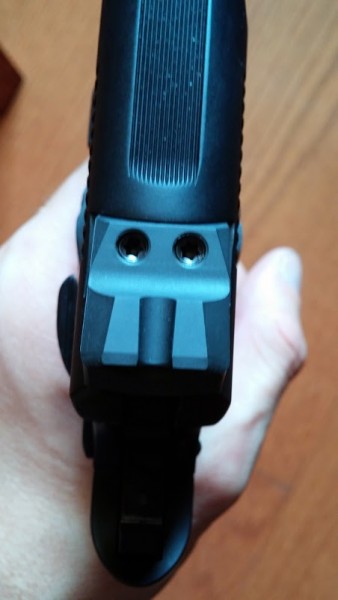


The top of the slide is serrated. It is done cleanly and sharply. It is supposed to reduced glare and can allow more sight picture because the top of slide is lower. I doubt it really helps either but it looks nice.
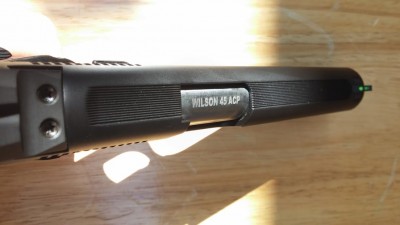
The sides of the slide have nice serrations. Like everything else they are cut cleanly and smoothly. The serrations are square but not sharp. They have a classic look which I like. The serrations are angled slightly forward. At the base of the serrations the finish is smooth and there are no machining marks visible. The front cocking serrations were left of this pistol. I prefer the smoother look of the slide without the front cocking serrations. The left side of the slide is engraved in, WILSON COMBAT and the right side is engraved, CQB ELITE. The size and depth of the engraving is not overdone and is somewhat subdued. It appears that they use different fonts for each side of the slide. The cqb elite looks like the stencil letters used in the army. The Wilson combat engraving is just a standard font. I would prefer something a little more elegant but this pistol is going to get used so utilitarian works.

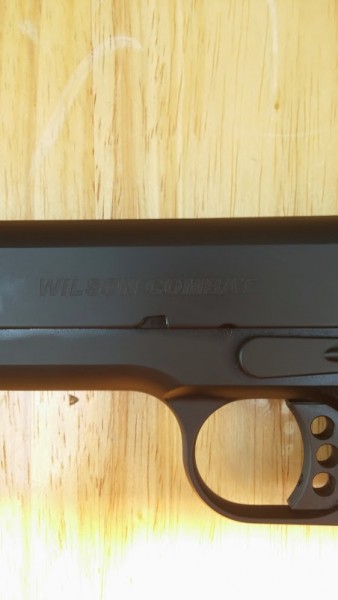
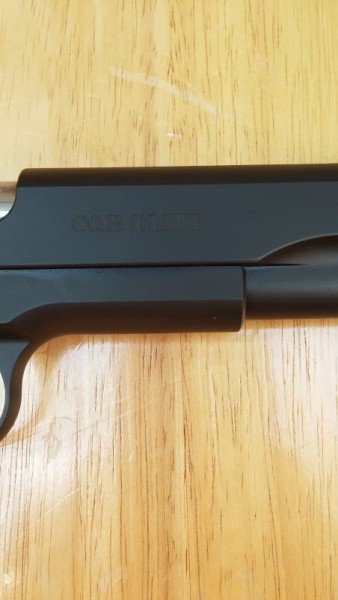
The magazine release is checkered and works smoothly. No grit or stickiness can be felt when using it. The grips have a small cutout to access the mag release. I prefer a little more scoop but it is perfectly functional.
The slide stop has serrations on top and a straight shelf. The shelf is smaller but has been perfectly functional with no misses during reloads. One of the additional options on this pistol is a flush cut slide stop. On the right side of the frame the slide stop typically protrudes slightly. With a flush cut slide stop when you have your finger off the trigger and indexing on the frame there is no bump under it. This is just a preference of mine and I also think it makes the pistol look smoother. The end of the slide stop is cutoff square as opposed to the typical round finish. This does make it a little harder to reinstall because you have to have the link lined up perfectly with the hold in the frame. With a round end it will center the link on itself if you are close. A nice touch with the slide stop is a milled channel for the slide stop plunger. This prevents the dreaded idiot mark when pushing the slide stop back in.
At the front of the gun is another option I wanted. The barrel is flush cut and polished. Normally a small amount of the barrel extends past the barrel bushing. I was able to take down the gun without using a bushing wrench. The barrel bushing is flush with the recoil spring plug.

The trigger is a three hole design. The trigger pull is the best I have felt…on anything. There is a very short smooth takeup and then it breaks. It measured consistently at 3.25 on my gauge. My gauge tends to run a little a low. Factory spec is 3.5 to 3.75. The trigger has the very smallest amount of vertical and horizontal play. Small enough that I couldn’t measure or estimate it. I am guessing it is just enough play to keep the trigger working smoothly without binding up in the channel, which it does.

The inside of the pistol is how you would expect. The frame feed ramp is wide and smooth as is the barrel feed ramp. There are some very light machining marks inside the dust cover. The left side of the ejection port inside the frame also has very light machining marks. I have never seen a 1911 without these marks. I am sure some exist. These have no bearing on anything and they are far less than I have seen in other semi custom 1911.
After going over the pistol again and again I was able to find some minor flaws. These are extremely nitpicky but they are there and I will point them out. I would be very surprised if most people would even locate these flaws if they had the pistol for 20 minutes. I previously mentioned a line of left over material on the rear slide. The slide stop is supposed to be cut flush with the frame on the right side. It isn’t perfectly flush. If you hold the frame level with your eye you can see that the end of the pin protrudes a tiny bit from the frame. The last thing I found is that the barrel muzzle is also not flush. When the pistol is in battery the muzzle rests in the barrel bushing. At the top of the bushing the muzzle is flush with the edge of the bushing. At the bottom of the bushing there is gap between the muzzle and the edge of the bushing. I took the barrel out and I could see that the muzzle isn’t perfectly square. This is causing what I see happening inside the bushing. There is the possibility that the muzzle not being perfectly square could impact accuracy. Only shooting the gun will show it. The pistol comes with a test target shot at 15yds. Wilson says these are not shot for accuracy but it does show the pistol will at least shoot what is shown and possibly better. My group measured 1.089 edge to edge for a .639 inch group. Based on just this the pistol should be able to shoot 1’’ groups at 25 yards.
After looking over the muzzle some more I decided to contact Wilson Combat. I sent the pistol back to them. They confirmed that the muzzle was not cut square. A little disappointing. Wilson ended up paying for shipping both ways and returned the pistol back to me fixed. The picture below is after the repair.
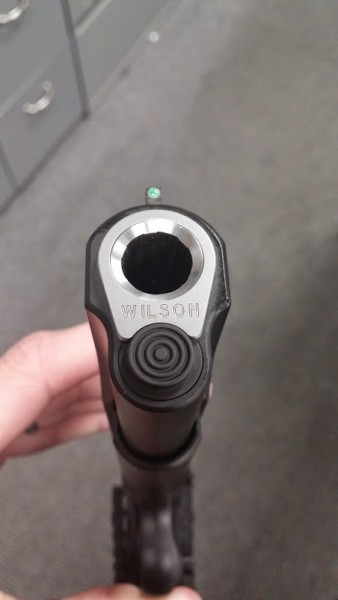

As I wrote about earlier these pistols have a very long wait time if you order one from Wilson Combat. The advantage is that you can pick exactly what features you want. I was fortunate that I found mine at www.clayandwings.com. From what I understand Joe Rankin of this site orders many pistols from Wilson Combat and has a relationship with them. He was excellent to deal with and even shipped my pistol the same day I ordered. The pistol was similarly priced as if I had bought it through Wilson Combat.
